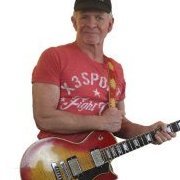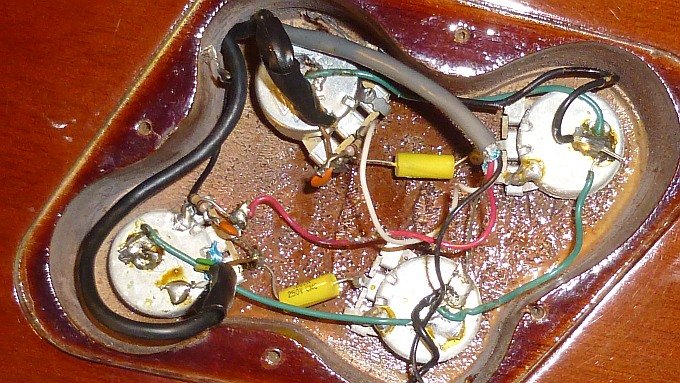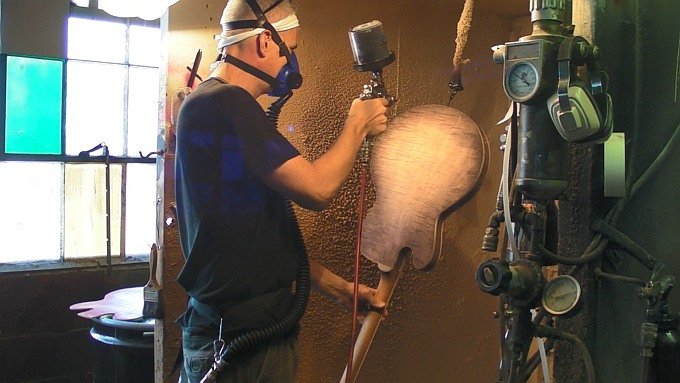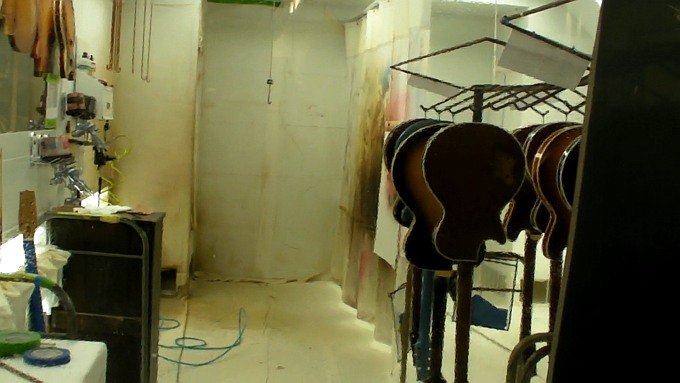-
Posts
1646 -
Joined
-
Last visited
-
Days Won
166
TalismanRich last won the day on April 25
TalismanRich had the most liked content!
Profile Information
-
Gender
Male
-
Location
The Derby City
TalismanRich's Achievements
-
Don't dilute the naphtha with anything. Nitrocellulose resins are totally insoluble in VM&P naphtha. The grades that are used by Heritage are dissolved in acetone and I think they might use a touch of alcohol. You don't want to soak the finish, but a dampened rag should be sufficient. It will evaporate quickly. Make sure you use it in a well ventilated area. Stay away from water heaters and furnaces.
-
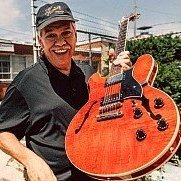
Heritage H150 traditionally best built years/eras?
TalismanRich replied to hopkinwfg's topic in Heritage Guitars
From the stand point of body thickness, binding and angles, I haven't seen any real change until the CC. The CC headstock size and neck angle are different from the standard. I also remember there being a difference with the body carve between the standard and CC line. I haven't played a newer standard in a year, so I'm going on memory here, but the standard 150 felt similar to my 2003 157, except the neck was a touch beefier, more like my 535. -
The problem is that the smoke gets embedded in the bare wood inside with a semi or hollow body. It becomes a case of "dilution is the solution". Constant airflow gradually draws out the smoke. Unfortunately, it takes time for that to happen. For an H-150 style, wiping it down with naphtha would do the trick since only the lacquer and fretboard get exposed. It should remove the majority of the chemicals from the smoke.
-
I've missed the Bird's keen eye for photos! You always caught such great moments.
-
Wow! You use the key? In the past 60 years, I don't know that I have ever locked a guitar case. What's the point? If someone wanted to steal my guitar, they would just pick up the case and walk away. 😉 I don't even remember getting a key with any of my guitars. The after market case I bought from GC had two in the box. They're still there.
-
I also like the fact that he brings up the advertising aspect. One of the things that was always a weak point for Heritage was advertising. It's the old "lamp under a bushel" syndrome. If people don't know know about you, they won't seek out your products. It would be interesting to compare the two guitars. I don't particularly like a really tall fret. I feel like I press too hard, which makes things go sharp if the frets are tall. Maybe my grip is too strong, but I've always played that way. I liked the way the pickups sounded. I tend to favor a neck or both pickups. The bridge always sounds too thin for me. That one had a bit of beef on the bottom, which sounded nice to me.
-
When I first got my 535 it had a pretty significant smoke smell. I used Febreeze on the case a few times along with a fan blowing on it. For the guitar itself, I had air blowing in one side for days on end, which lowered it quite a bit. I also tried spritzing some Febreeze inside the hole... I don't know that it did a lot but it masked a bit of the smell. Eventually, the smell diminished and now it's fine. You can get a small USB powered fan that you could use to blow air into one F-hole. Just let it run for as long as you want. I had an old computer CPU fan that ran from a 12v power supply. Some people say that an ionizer or ozone generator works, but you don't want an ozone buildup in your house. If you could put it in a garage or something, it might be ok.
-

Heritage H150 traditionally best built years/eras?
TalismanRich replied to hopkinwfg's topic in Heritage Guitars
One problem with trying to nail down the best guitar by year is that they never really seemed to nail down a "spec change" vs year. Lots of 150s were customized to some degree, and parts used were pretty consistent over the years, at least until Schaller exited parts of the market. Schaller pickups and bridge hardware, Vishay caps, Grover tuners, Jesco frets were pretty much standard items until the mid/late 2000s. Then they went with SD59s or Seths, and a TOM bridge style. The CC series were a departure in many regards, based on Edwin Wilson's specs. There were variations in the neck thickness but they would accommodate requests. The necks were rolled by hand. They have some templates to use as guides, but they didn't vary drastically. I have guitars built in 87, 2000, 2003 and 2005. The necks are reasonably close, somewhat thin for some people's taste but I think they are very comfortable. There are guitars built with chunky necks if the person ordering asked for it. As Dave and Kuz said, judge each guitar on a "case by case basis". -
I've always liked the T5. I played one years ago and it felt very comfortable, and it had a large variety of sounds. I've considered buying one, but I really don't have a need. If I was playing out I probably would have grabbed one. Having a passable acoustic sound as well as electric sounds would be great for live work. If anything, Heritage has proven to be a pretty traditional company. They have done some radical designs years ago, (Little One, SAE, Kahuna, HB1 and 2, Mark Slaughter, etc) but they have never been big sellers. Their bread and butter styles are the solid body LP style, the semi, and the archtops. The Millennium is a pretty unique design, but apparently it wasn't a good enough market to keep it in the lineup, although I've heard a few "maybe" comments. While they did some acoustics early in the company history, it was never a focus. Building acoustics seems to be a different "technique". Some acoustics had bodies made by another company, with a Heritage neck and finishing. I also don't know that they have a production room to do an acoustic series. Even Gibson does it's acoustics in a totally different location from it's electrics.
-
I can't see Heritage going with anything other than solid rim and carved body. Plus when they do the laminate for the 535 and 525s, they use basswood and maple to make the laminate if memory serves me. They may just be using select pieces of maple to do the body vs "standard" maple.
-
I think the fret wire is standard Jesco stuff. It's pretty much used industry wide, unless you go with stainless. I don't remember the number, though. The caps in most Heritages are Vishay MKT metalized film. They are yellow axial capacitors and are good caps. The pots can vary over the years, depending on availability. They use standard audio taper pots. I have tried changing pots and to be honest, sonically there was no change. I had one that was scratchy, so I replaced all 4 with CTS pots. The only difference was in the feel, as I used low torque CTS with a 15% taper which changes the rate of volume change as you turn the knob. They also made it easier to turn, which might be good or bad, depending on your style. Wire is wire... You can get nice cloth covered vintage style wire, but it won't change the sound. It's pretty and if you want it to look like 1959, then go for it. Jacks and switches are pretty much generic. If they are clean and work, they're good. If they get dirty and noisy, or cut out, then change them out. I've used Switchcraft and cheapos from China and as long as they are quiet and solid, they're fine. Depending on how you like to roll off volume, I added a treble bleed to my 157 for a while. I liked it's effect more than 50s wiring or standard wiring. Here's my 157 control cavity with treble bleeds and the stock pots and caps. As I had changed a noisy switch, I changed the cable running up to the switch with a shielded cable. (the grey stuff).
-
That thing really cries out for a Floyd Rose! 😁
-
If I remember correctly, when they were relocating to the other part of the building, didn't they toss a lot of the old patterns out? Someone had a bunch of Heritage stuff like that on Reverb or Ebay or something. That was a few years back so maybe I'm not remembering it correctly. Does anyone else recall that episode? If that happened, then making new Stats or Parsons Street guitars would truly be a custom build, from sketching it out on the wood plank and putting it on the band saw to shaping the curves of the headstock. It would probably be easier to get and independent builder to make a copy. Granted it wouldn't be a "Heritage" but if you were really hooked on getting a particular style guitar, that would be one way to do it. Probably wouldn't be cheap tho!
-
Welcome LL. The resident "expert" on lefty guitars would be Lefty Alicia. She has been at most of our PSPs with various guitars. Here's her Millennium.
-
I don't know about going back to the old business model. It may have something to do with actually making a profit (silly concept, I know). I'm not privy to the financial status of the old company, but I had heard several times that things were indeed often on a "shoestring budget". There were times that I wondered if the owners even paid themselves. It seemed to be more a labor of love. This isn't Jim and Marv building a few guitars. I'm sure that they make a lot more guitars today than they did 15 years ago. Sweetwater alone has 65 guitars listed. CME has 22 listed. Jay Wolfe has 25. That's just 3 dealers. You didn't really see those numbers years ago. Have you visited the factory? The "big money" helped pay for a new dust collection system that makes the place safer, a humidity and temperature control system, a new spray booth where you don't really have to worry about dust contaminating your fresh lacquer, the Plek machine and more. The old factory, while quaint, was really pretty scary from a EHS standpoint. Lots of dust and wood laying around. The spray booth upstairs was open air, so dirt and dust was floating around. It was also quite dangerous, with nitrocellulose coating the entire booth. That stuff is a lot more flammable than some people realize. The business will need to pay for that upgraded equipment. It wasn't free! To their credit, Heritage is still making archtops (the 575 and Eagle Classic). Try to get a new archtop from Gibson. The last one listed was the Chuck Berry ES 350, but it's discontinued. There are a few dozen people making teles and strats. Fender, G&L, Suhr, LSR, PRS, and ton of low cost import versions.

